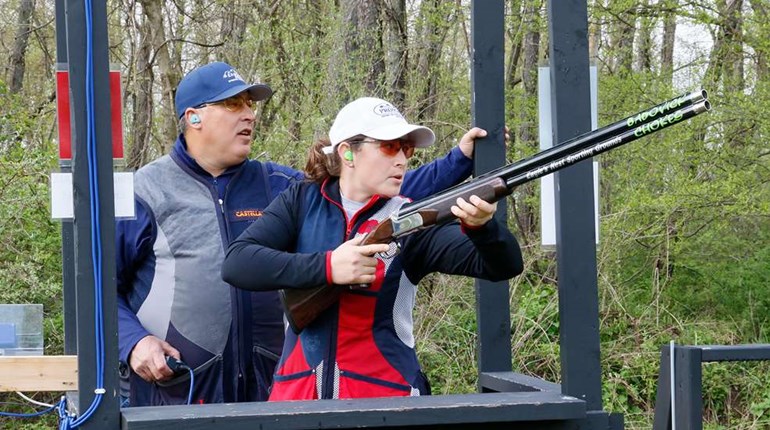
For beginning shotgunners, the most difficult concept in the steep learning curve of wingshooting is how much to “lead” a target, whether clay or gamebird. Years ago, when I was first learning to wingshoot, I was fortunate to have an experience in a duck marsh that showed me visually just how far off I was in calculating lead.
It was an early Ohio teal season, September, so mosquitoes were still in full force. As I sat swatting the droning critters, a tightly packed flock of four blue-wings rapidly approached my few decoys, twisting and turning in flight as teal do. As I was trying to decide which bird to shoot first should they come into range, the fast-flying ducks conveniently strung out in a straight line, spaced themselves a foot apart, and flew parallel to my position at about 30 yards.
“Perfect!” I thought. “I’ll shoot the lead duck, then hope to double on one of the other three.”
That’s not what happened. Swinging on the first teal and slapping the trigger of my 12-gauge Remington Wingmaster pump gun, the third duck in the line fell dead. I was so astonished that I didn’t even think to shoot again. Since teal are about 15 inches in length and the ducks were flying about a foot apart, I had shot at least four and a half feet behind the first bird of the flock! During the drive home, that incident had me reconsidering everything I thought I knew about leading a target with a shotgun.
So how should you go about determining target lead? The late outdoor writer Bob Brister, in his classic book Shotgunning: The Art and the Science, writes the following in the book’s chapter titled Forward Allowance:
“The easiest way to hit flying game is to swing the barrel through the bird as if to paint it out of the sky. That rash recommendation comes after more than twenty years of taking the trouble to watch directly over the shoulders of some of the world’s finest shots and that is how most of them do it. Precisely when they pull the trigger depends upon distance, speed of target, and angle, the judgement of all three being one of the main reasons for moving the gun barrel through the target at the last instant before firing. It’s like giving the mental computer a last-minute readout on all the variables.”
That particular shooting technique described by Brister is known as the Swing-through method. I personally don’t choose to use that approach to wingshooting, but not because it is not effective. I was simply taught another shooting method known by any of three names: Instinctive, English or Churchill.
The Instinctive method differs from swing-through in that you simply point the shotgun at the flying target and pull the trigger. Some shooters believe there is no lead required with this method. That’s not true, as according to the laws of physics every moving target requires a lead of some length—short or long—in order to hit it. But the instinctive method can appear to the shooter to require little or no lead because your body builds in a natural, almost imperceptible lead as you swing your shotgun toward the target.
For most shooters, the Instinctive method of shotgunning works well out to about 40 yards. Beyond that distance the number of hits begins to decline rapidly. I stay with the method not only because I’ve shot that way most of my adult life, but because in addition to being a clay-target shooter I’m also a hunter—doves and pheasants mostly—and usually don’t shoot at gamebirds beyond 40 yards to reduce crippling loss.
A third shotgunning method for determining lead allows you to shoot both shorter and longer distances, out to 50, 60, even 70 yards if you so choose. It’s called the Sustained-lead method, and here’s how it works.
Instead of pointing directly at a moving target (Instinctive) or moving your shotgun muzzle through a moving target (Swing-through), Sustained-lead shooters place the shotgun’s muzzle in front of the moving target, match the target’s speed and then pull the trigger. In other words, the gun’s muzzle starts in front of the target and stays in front of the target.
No matter which of those three common shotgunning methods you use, keep in mind that your eyes can only focus on one thing at a time and that one thing should be the leading edge of the target. With the Swing-through and Sustained-lead methods, your shotgun’s muzzle will appear blurry in the periphery of your vision.
With the Instinctive method, your shotgun muzzle may also appear blurred, if you see it at all. Some Instinctive shotgun shooters report not even being aware of their muzzle because they are focused so intently on the target, and that’s a good thing.
With any of the three methods, precisely when to pull the trigger is key. You’ll notice that Brister said it “depends upon distance, speed of target and angle.” Which only comes with experience, and that experience comes by shooting—lots of shooting.
Another tip is to always shoot a shotgun with both of your eyes open. Simply point and shoot, don’t aim. Aiming, lining up a front and rear sight with the target, is for shooting handguns and rifles. If you try that approach with a shotgun, the target will be long gone before you get those points aligned. Again, simply point and shoot a shotgun.
Lastly, as with any hand-eye coordination sport, all three of these shotgunning methods mentioned take time to learn. And once you’ve learned a basic technique, you must then continually practice it to ingrain those skills into your muscle memory and mental sight picture. But not to worry, that just means you should shoot more often, and that means more fun! A reputable shotgun coach can help you get started.






































